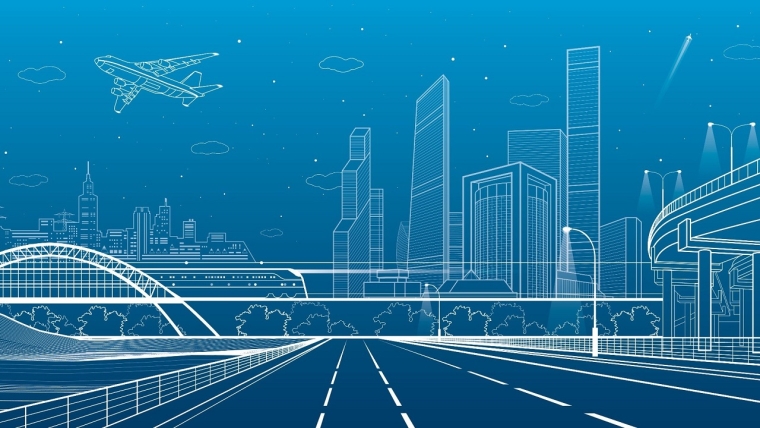
This is a re-post of an article originally published on pundit.co.nz. It is here with permission.
I was astonished to learn that the quantity of our infrastructure has been keeping up with economic growth.
Your paper almost certainly has daily reports of inadequacies in the land transport system (not to mention your travel being delayed by congestion), the energy system, and hospital and school buildings while at least once a week it probably draws attention to a telecommunications breakdown or failures in the three waters systems (more often if you live in certain cities). Similar incidents for airports and seaports pop up too.
Grumbling aside, the economic history of New Zealand illustrates why these shortages happen. The international Great Depression of the early 1930s first hit New Zealand when public works laid off workers because there were no funds to pay them. During the Second World War resources were diverted from building infrastructure to fighting (thereby causing the electricity shortages with the blackouts of the early 1950s). When Robert Muldoon hit a fiscal crisis shortly after coming to office in 1975, he immediately cut public investment. In each case economic difficulties meant we shortened our investment horizon, focusing on the present at the cost of providing for the future. A decade later Rogernomics couldn’t work out how to commercialise some of the infrastructure – privatisation did not always work for roads, say – and left a muddle. This time commercialisation shortened the time horizons of investment.
Unfortunately, we have a statistical series for infrastructure only back to 1990 so I cannot turn the previous paragraph’s qualitative story into a quantitative one: the data series since has been based on Statistics New Zealand (SNZ) data and the analysis was provided by the Infrastructure Commission* (IC) (here). It shows infrastructure growing more slowly until about 1997, stagnating through to 2004, expanding to 2013 and then stagnating (keeping up with GDP growth) thereafter.
Before reporting the results, I need to say something about the measure which SNZ uses for all its capital stock estimates. It takes the value for assets in one year, adjusts them for inflation, depreciates them for wearing out, and adds in new investment.
The method of depreciation is tricky and may explain part of the almost paradoxical findings. I avoid the technical issue with an illustration. Recently a 132-year-old Wellington fresh-water pipe collapsed. The depreciation formula will value the still functioning pipe as zero. When it ruptures it will be replaced by a new one, the cost of which will be added to the value of the infrastructure. Presumably that will not affect the availability of the water to users (except for fewer interruptions). The new pipes’ contribution to GDP productivity is near zero.
The cost of extending infrastructure may not always be as productive as the existing infrastructure. Doubling a road width is likely to cost more than the original cost of the road. Sometimes it may be. The replacement of the copper wire network with the broadband one created possibilities which would have been beyond the ken of Alexander Bell.
Even so, the new infrastructure may add to human welfare without adding to material productivity. We benefit from less traffic congestion, children benefit if the classrooms are not damp, increasing earthquake resilience is of little value until one day the big one happens.
These valuation issues may explain the increasing grumbling, despite the effort of infrastructure growth keeping up with economic growth. So I proceed cautiously, using the data to provide insights which are reasonably robust in these issues. I am going to the use capital to annual GDP provided by IC as percentages. A constant percentage means infrastructure has been growing as fast as material output, a rising one that the capital stock is increasing faster than GDP. I compare 1990, the first year available, with 2022, the last year. I’ve summarised my investigations in the following table.
Infrastructure Capital Relative to Annual GDP
-
Infrastructure Sector (Ownership) 1990 2022 Change
-
Road Transport (Public) 14.3% 18.6% 4.3%
-
Rail, Water, Air & Other Transport (Public) 2.3% 2.2% -0.1%
-
Public Administration & Safety (Public) 8.1% 8.7% 0.6%
-
Social Housing (Public) 7.9% 3.3% -4.6%
-
Other Public Capital (Public) 1.9% 2.8% 0.9%
-
Preschool & School Education (Mixed88%) 9.5% 7.6% -1.9%
-
Tertiary Education (Mixed92%) 2.2% 4.5% 2.3%
-
Hospitals (Mixed91%) 5.3% 3.9% -1.4%
-
Water, Sewerage, Drainage & Waste Services (Mixed68%) 5.1% 9.2% 4.1%
-
Electricity & Gas Services (Commercial) 14.6% 12.9% -1.7%
-
Telecommunications Services (Commercial) 6.9% 5.7% -1.2%
-
TOTAL 78.1% 79.4% 1.3%
A warning about terminology. You’ll have to look up SNZ definitions to see what exactly each sector covers. Second, I have listed the sector ownership. ‘Commercial’ may be misleading for it includes publicly owned (or partially owned) trading enterprises (such as Meridian Energy, Genesis Energy and Mercury Energy). There is also mixed ownership (according to SNZ definitions) in some sectors – the number after the ‘mixed’ is the proportion of the infrastructure which is publicly owned. ‘Public’ includes both central and local government. (Phew! about definitions.)
What we see in the table is that infrastructural capital has grown slightly faster than GDP over the 32 years. When judging we should remember that, as hinted in the second paragraph, we may have had an infrastructural deficit in 1990. In which case we may not have caught up.
The interest in the table might be the change in the composition of the infrastructure. I was surprised that the three waters sector’s infrastructure has increased substantially, as has that of the land transport sector. That is not the impression that the grumbling gives. The infrastructure of the commercially owned sectors of electricity and telecommunications have increased more slowly than GDP. Each of these potential paradoxes needs to be investigated.
Less surprising is that social housing has decreased significantly given the policies towards it that governments have been pursuing. (There is no information here about the stock of privately owned housing.) The relative reduction in core education probably reflects slow growth in the age groups, but possibly also that school buildings are not being upgraded. On the other hand, tertiary education has been adding to its buildings.
The healthcare sector is more perplexing. Healthcare spending has been increasing relative to GDP, but the buildings and equipment they use have not.
I leave investigating these issues to others and other occasions. My point is that the IC report Build or maintain? New Zealand’s infrastructure asset value, investment, and depreciation, 1990–2022 is a useful contribution to our understanding of the way the economy has been developing ... and not developing.
It and the other work of IC demonstrates that thinking systematically about infrastructure is vitally necessary for New Zealand’s development. The politicians agree and are prioritising it.
The Minister for Infrastructure, Chris Bishop, has just announced his government’s policy which includes an Infrastructure Commission to further embed the sector into the government system. Having set out the policy he said that it should be bi-partisan because it involved the long term. A bit like the Red Queen – policy first; consensus after? The other political parties were not amused. Perhaps the minister should involve them in establishing the membership of the new commission.
*An earlier version of this article referred to a report by Infrastructure New Zealand. This has been corrected to read that the report is by the Infrastructure Commission.
*Brian Easton, an independent scholar, is an economist, social statistician, public policy analyst and historian. He was the Listener economic columnist from 1978 to 2014. This is a re-post of an article originally published on pundit.co.nz. It is here with permission.
5 Comments
Infrastructure Capital Relative to Annual GDP
But, what would the stats say if we measured Infrastructure Capital relative to population growth?
I suspect, therein lies the problem.
I agree you should compare the proportion of investment in infrastructure with GDP/Capita. This will show a complete different outcome and makes the deficit clear!
Do we have an infrastructure deficit?
If we look at what is available and how it performs then the answer is clearly yes.
Performance also takes into account how that asset it used, and that is where we are failing. It's also a much harder ask (politically) to fix.
Congestion charging, infill housing, universal water metering, among other things.
We're keeping up with infrastructure by suppressing development if that makes sense. By applying massive infrastructure growth charges, and making developers pay for roads, water and electrical infrastructure, they certainly have kept up with infrastructure costs. At the expense of making all development in NZ extremely expensive. Those things are meant to be government provided utilities. But ever since we abolished land tax, the wealthy and landed have shirked as much of their responsibilities as possible, while squeezing as much juice as possible out of the working classes.

We welcome your comments below. If you are not already registered, please register to comment
Remember we welcome robust, respectful and insightful debate. We don't welcome abusive or defamatory comments and will de-register those repeatedly making such comments. Our current comment policy is here.